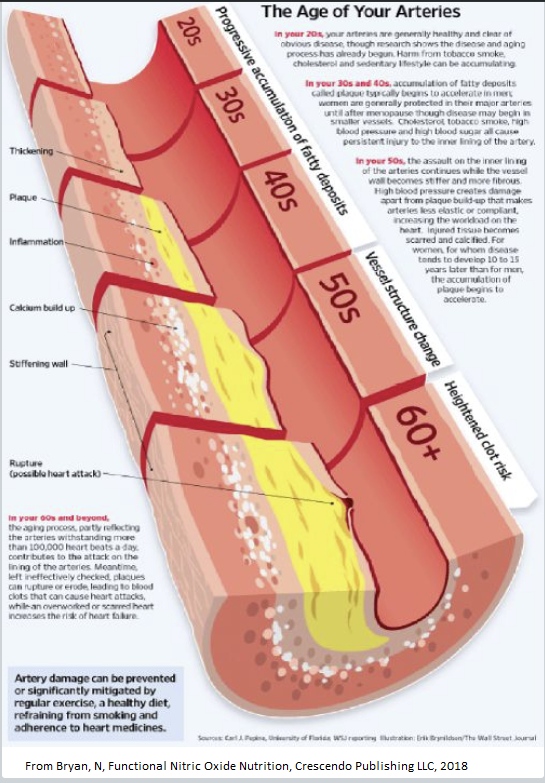
The endothelium is the innermost layer of blood vessels, which can become damaged as we get older, an important aspect of cardiovascular disease. I discovered the vital role of the endothelium when I discovered that I have high blood pressure if it is not controlled by metoprolol (a medicine I am on to prevent heart arrhythmias, which were a side effect of my needing a heart valve replacement). The blood pressure incident and what I subsequently learned from it is discussed here. My most important takeaway was to make sure I have lots of nitrates in my diet, from foods like beets and arugula. That has been working well for keeping blood pressure normal. But that is helping to keep my blood vessels dilating normally, despite age-related damage to the endothelium. As I mentioned at the end of that previous post, I’d like to learn about how to reduce damage to the endothelium.
It turns out this is possible, and this is discussed in the latest video on Dr. Greger’s nutritionfacts website. The key is the role of endothelial progenitor cells, which help with the health of the endothelium. In the video a fascinating study is described that demonstrates this. Peripheral artery disease is a type of cardiovascular disease the affects blood vessels like the legs, in a similar manner to how the coronary arteries are damaged in coronary artery disease. The blood vessels can be so badly damaged that sufferers are severely limited in exercise capacity, like only being able to walk for a minute or less. In addition, necessity for amputation can be a major consequence of peripheral artery disease. The researchers split participants into a group that received bone marrow transplants, and a control group that received only an injection of their own blood. The group with bone marrow transplants had significantly improved exercise time, versus no improvement in the control. Also, in the control group, during follow-up over the subsequent months, 14% required amputations over the subsequent months versus none in the treated group. The improved arterial function in the treated group is related to enhanced effect of endothelial progenitor cells [2].
So Dr. Greger now examined how can we boost endothelial progenitor cells by lifestyle means. Two vital factors are not smoking (and avoiding exposure to secondhand smoke), and exercise. For diet, important factors are reducing saturated fat intake, eating a whole-food plant-based diet, and specifically eating berries, onions, and drinking green tea. I’m already checking all the boxes on this list except the last two, so I intend to boost onion consumption and try green tea. The endothelium of my arteries probably already looks like the “60+” in the picture above. It’s exciting to think it’s possible to reverse this and have effectively younger arteries.
References
- Sharma, S, et al, “Randomized, Double-Blind, Placebo-Controlled Trial to Evaluate Safety and Therapeutic Efficacy of Angiogenesis Induced by Intraarterial Autologous Bone Marrow–Derived Stem Cells in Patients with Severe Peripheral Arterial Disease”, Journal of Vascular and Interventional Radiology, 2021. online here
- Teraa, M, et al, “Effect of repetitive intra-arterial infusion of bone marrow mononuclear cells in patients with no-option limb ischemia: the randomized, double-blind, placebo-controlled Rejuvenating Endothelial Progenitor Cells via Transcutaneous Intra-arterial Supplementation”, Circulation, 2015. online here.
